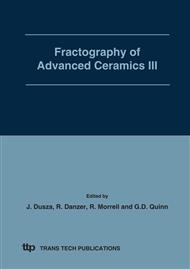p.346
p.350
p.354
p.358
p.362
p.365
p.369
p.373
p.377
The Compressibility Behaviour of a New Generation of Coated Metal/Ceramic Composite Powders
Abstract:
The present work deals with the compressibility behaviour of a new generation of coated metal/ceramic composite powders. A commercial 316L stainless steel powder was coated with the alumina layer by an aqueous sol-gel colloidal process and then metal/ceramic composite materials were produced with core/shell structure. The powders were uniaxially cold pressed in a cylindrical die in the range from 200 to 1000 MPa. In order to reach the best green density, composite powders have been added with 1% in weight of lubricant. The compressibility behaviour was analysed using the equation P = P0.exp (-K.pn). P0 is the relative apparent density and p is applied pressure; K and n are the parameters with defined physic-metallurgical substance. The values of the parameters K and n were determined by regression analyses. The correlation coefficients r of experimental compaction curves were up to 0.98. The results showed that difference between metal/alumina weight ratios affected the compressibility parameters as well as compressibility curves.
Info:
Periodical:
Pages:
362-364
Citation:
Online since:
March 2009
Authors:
Price:
Сopyright:
© 2009 Trans Tech Publications Ltd. All Rights Reserved
Share:
Citation:


